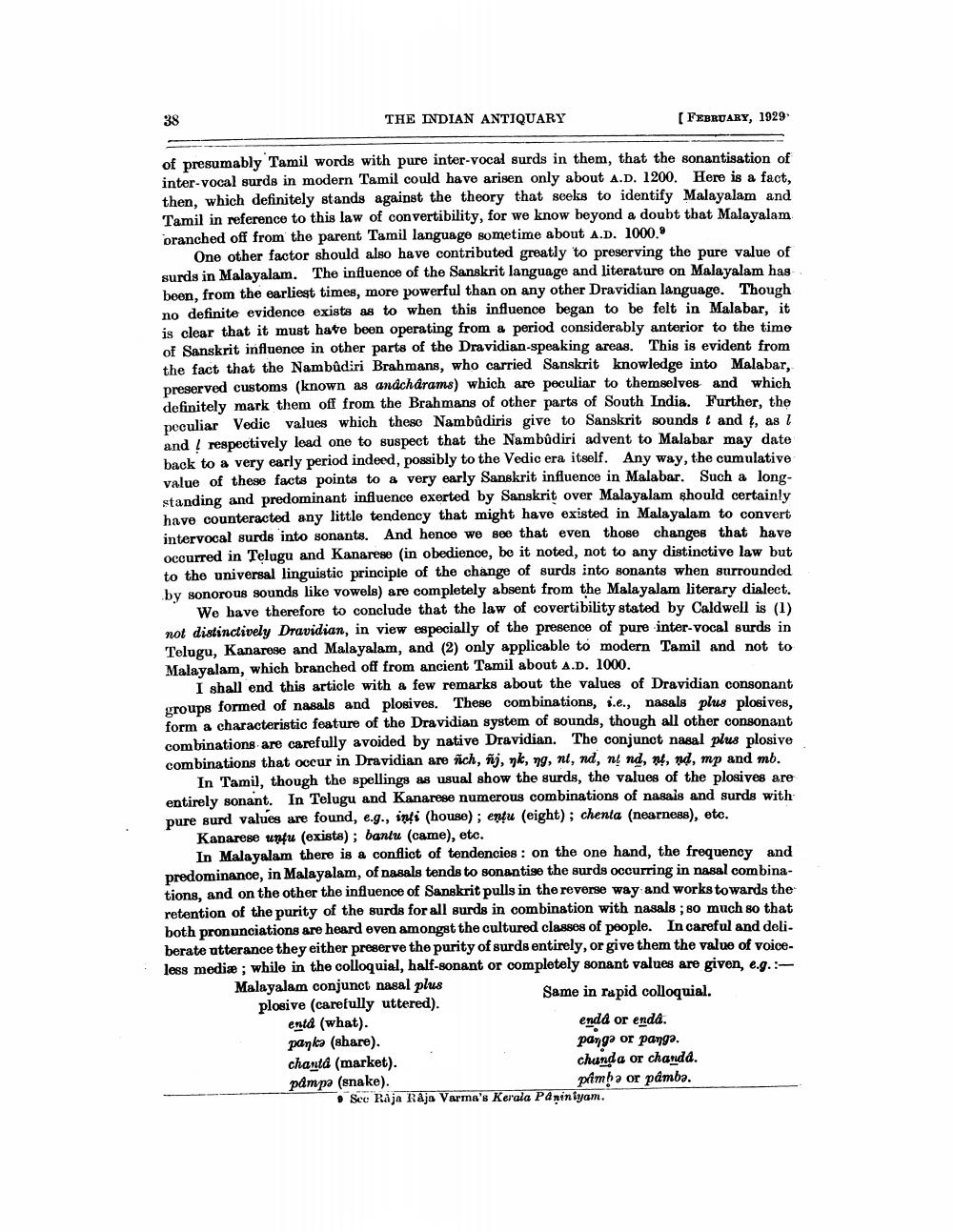________________
THE INDIAN ANTIQUARY
(FEBRUARY, 1929
VF till
of presumably Tamil words with pure inter-vocal surds in them, that the sonantisation of inter-vocal surds in modern Tamil could have arisen only about A.D. 1200. Here is a fact, then, which definitely stands against the theory that seeks to identify Malayalam and Tamil in reference to this law of convertibility, for we know beyond a doubt that Malayalam oranched off from the parent Tamil language sometime about A.D. 1000.
One other factor should also have contributed greatly to preserving the pure value of surds in Malayalam. The influence of the Sanskrit language and literature on Malayalam has been, from the earliest times, more powerful than on any other Dravidian language. Though no definite evidence exists as to when this influence began to be felt in Malabar, it is clear that it must hate been operating from a period considerably anterior to the time of Sanskrit influence in other parts of the Dravidian-speaking areas. This is evident from the fact that the Nambûdiri Brahmans, who carried Sanskrit knowledge into Malabar, preserved customs (known as andchárams) which are peculiar to themselves and which definitely mark them off from the Brahmans of other parts of South India. Further, the peculiar Vedic values which these Nambândiris give to Sanskrit sounds t and t, as I and respectively load one to suspect that the Nambûdiri advent to Malabar may date back to a very early period indeed, possibly to the Vedic era itself. Any way, the cumulative value of these facts points to a very early Sanskrit influence in Malabar. Such a longstanding and predominant influence exerted by Sanskrit over Malayalam should certainly have counteracted any little tendency that might have existed in Malayalam to convert intervocal surds into sonants. And hence we see that even those changes that have occurred in Telugu and Kanarese (in obedience, be it noted, not to any distinctive law but to the universal linguistic principle of the change of surds into sonants when surrounded by sonorous sounds liko vowels) are completely absent from the Malayalam literary dialect.
We have therefore to conclude that the law of covertibility stated by Caldwell is (1) not distinctively Dravidian, in view especially of the presence of pure inter-vocal surds in Telugu, Kanarose and Malayalam, and (2) only applicable to modern Tamil and not to Malayalam, which branched off from ancient Tamil about A.D. 1000.
I shall end this article with a few remarks about the values of Dravidian consonant vroups formed of nasals and plosives. These combinations, i.e., nasals plus plosives, form a characteristic feature of the Dravidian system of sounds, though all other consonant combinations are carefully avoided by native Dravidian. The conjunct nasal plus plosive combinations that occur in Dravidian are ñch, ñj, nk, ng, nt, nd, nt nd, n, nd, mp and mb.
In Tamil, though the spellings as usual show the surds, the values of the plosives are entirely sonant. In Telugu and Kanarese numerous combinations of nasals and surds with pure surd values are found, e.g., infi (house); entu (eight); chenta (nearness), etc.
Kanarese unfu (exists); bantu (came), etc.
In Malayalam there is a conflict of tendencies : on the one hand, the frequency and predominance, in Malayalam, of nasals tends to sonantise the surds occurring in nasal combinations, and on the other the influence of Sanskrit pulls in the reverse way and works towards the retention of the purity of the surds for all surds in combination with nasals ; 80 much so that both pronunciations are heard even amongst the cultured classes of people. In careful and deliberate utterance they either preserve the purity of surds entirely, or give them the value of voiceless mediæ ; while in the colloquial, half-sonant or completely sonant values are given, e.g.: Malayalam conjunct nasal plus
Same in rapid colloquial. plosive (carefully uttered). entd (what).
endd or enda. panko (share).
pango or panga. chanta (market).
chunda or chanda. pampe (snake).
primba or påmba. • See Raja Raja Varma's Kerala Paniniyam.




